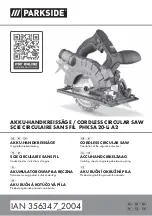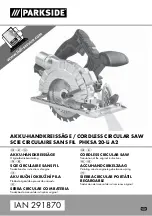
-44-
G0513 Series Bandsaws (Mfd. Since 08/22)
Workpiece
Inspection
Some wood workpieces are not safe to cut or may
require modification before they are safe to cut.
Before cutting wood, get in the habit of
inspecting all workpieces for the following:
•
Material Type: This machine is intended for
cutting natural and man-made wood products,
and laminate covered wood products. Cutting
drywall or cementitious backer board creates
extremely fine dust, which may reduce the
life of the bearings. This machine is NOT
designed to cut metal, glass, stone, tile, etc.
•
Foreign Objects: Nails, staples, dirt, rocks
and other foreign objects are often embed-
ded in wood. While cutting, these objects can
become dislodged and hit the operator or
break the blade, which might then fly apart.
Always visually inspect your workpiece for
these items. If they can't be removed, do
NOT cut the workpiece.
•
Large/Loose Knots: Loose knots can
become dislodged during the cutting opera-
tion. Large knots can cause blade damage.
Choose workpieces that do not have large/
loose knots or plan ahead to avoid cutting
through them.
•
Wet or "Green" Stock: Cutting wood with
a moisture content over 20% causes unnec-
essary wear on the blade and yields poor
results.
•
Excessive Warping: Workpieces with exces-
sive cupping, bowing, or twisting are danger-
ous to cut because they are unstable and can
move unpredictably when being cut. DO NOT
cut excessively warped wood.
•
Minor Warping: Workpieces with slight cup-
ping can be safely supported if the cupped
side faces the table or fence. On the contrary,
a workpiece supported on the bowed side will
rock during a cut, leading to loss of control.
General Overview
The bandsaw is one of the most versatile wood
cutting tools in the shop. It is capable of perform-
ing many different cutting functions including:
Straight Cuts
•
Miters
•
Angles
•
Compound Angles
•
Resawing
•
Ripping
•
Crosscutting
Irregular Cuts
•
Simple and Complex Curves
•
Duplicate Parts
•
Circles
•
Beveled Curves
A properly adjusted and tuned bandsaw can be
safer to operate than most other saws and per-
forms many functions with ease and accuracy.
Basic Cutting Tips
Here are some basic tips to follow when oper-
ating the bandsaw:
•
Replace, sharpen, and clean blades as nec-
essary and make adjustments periodically to
keep the saw always running in top condition.
•
Use a light and even feed rate while cutting.
Light contact with the blade will permit easier
line following and prevent undue friction.
•
Avoid trying to turn tight corners because this
will twist the blade. Remember, you must saw
around corners.
•
Misuse of the saw or using incorrect tech-
niques is unsafe and results in frustration and
poor cuts. Remember—the blade does the
cutting with the operator’s guidance.
Содержание EXTREME G0513X2
Страница 100: ......
















































